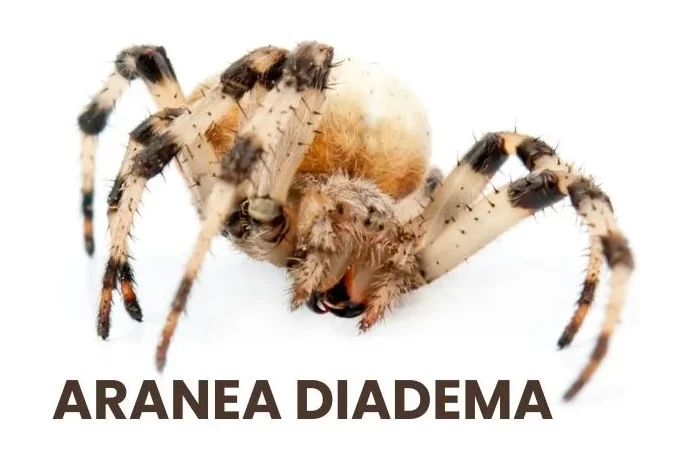Aranea Diadema, derived from the Papal-Cross Spider, is a remedy known for its influence on the nervous system. Characterized by periodicity, coldness, and a heightened susceptibility to dampness, it is particularly indicated for individuals with a constitution prone to malarial poisoning.

SOURCE INFORMATION
- Kingdom: Animalia
- Phylum: Arthropoda
- Class: Arachnida
- Order: Araneae
- Family: Araneidae
- Genus: Aranea
- Species: Diadema
Geographical Origin: Aranea Diadema, commonly known as the Papal-Cross Spider, can be found in various regions across Europe.
It inhabits gardens, fields, and wooded areas, often creating its distinctive orb-shaped webs.
Historical Facts
- Web Characteristics: The Papal-Cross Spider is known for its unique web, which often features a cross-like pattern in the centre. This characteristic has contributed to its common name.
- Cultural Significance: While not extensively documented in historical texts, spiders, in general, have held cultural significance in various societies. They are sometimes associated with symbolism, folklore, and mythologies. In some cultures, spiders are considered symbols of creativity and patience.
- Ecological Role: As a member of the arachnid family, Aranea Diadema plays a crucial role in the ecosystem by controlling insect populations through its predation on various small insects that become ensnared in its web.
- Ornamental Value: The distinctive appearance of the Papal-Cross Spider and its intriguing web design also contributes to its ornamental value in natural settings.
DRUG PATHOGENESIS
- Affinity for the nervous system, leading to symptoms characterized by periodicity.
- Heightened sensitivity to damp and cold conditions, resulting in persistent chilliness.
- Swelling and heaviness in various body parts, especially the hands and forearms.
- Influences the spleen, causing enlargement.
KEY CHARACTERISTICS
- Powerful action on the nervous system, similar to other spider poisons.
- Symptoms marked by periodicity, coldness, and extreme sensitivity to dampness.
- Associated with a hydrogenoid constitution, indicating abnormal sensitivity to damp and cold conditions.
- Patient feels cold to the bones, with an inability to find relief from the coldness.
- Sensation of parts being enlarged and heavier.
PARTICULAR ORGAN SYMPTOMS
- Head: Pain in the right trifacial nerve, confusion alleviated by smoking in the open air.
- Eyes: Heat and flickering, worsened in damp weather.
- Teeth: Sudden violent pain at night, especially after lying down.
- Female: Early and copious menses, abdominal distention, and lumbo-abdominal neuralgia.
- Chest: Pain in the intercostal nerve, bright red hemorrhage from the lungs.
- Stomach: Cramps after eating, epigastrium painful to pressure.
- Abdomen: Enlarged spleen, colic returning at the same hours, heaviness in the lower abdomen.
REMEDY RELATIONSHIP
- Complementary: Tela aranearum (Spider’s web).
- Related Remedies: Aranea Scinencia (Grey Spider), Heloderma, Cedron, Arsenic.
DOSE
- Tincture to thirtieth potency.
FREQUENTLY ASKED QUESTIONS
What distinguishes Aranea Diadema’s action on the nervous system?
- Similar to other spider poisons, it powerfully affects the nervous system, causing symptoms marked by periodicity.
What is a hydrogenoid constitution?
- It signifies abnormal sensitivity to damp and cold conditions, making the individual unable to tolerate living near fresh water or in damp, chilly places.
How does Aranea Diadema affect sleep?
- Restlessness and waking occur as if hands and forearms were swollen and heavy.
When is Aranea Diadema indicated for female symptoms?
- It is indicated for cases of early and copious menses, abdominal distention, and lumbo-abdominal neuralgia.
Meaning of Difficult Words
- Erethism: Abnormal irritability or nervousness.
- Hydrogenoid Constitution: Abnormal sensitivity to damp and cold conditions, indicating an increased susceptibility to ailments triggered by such environments.
